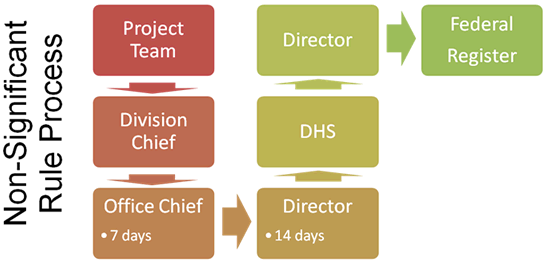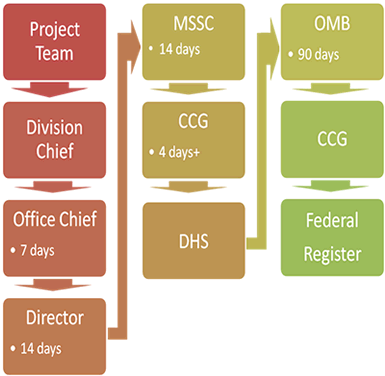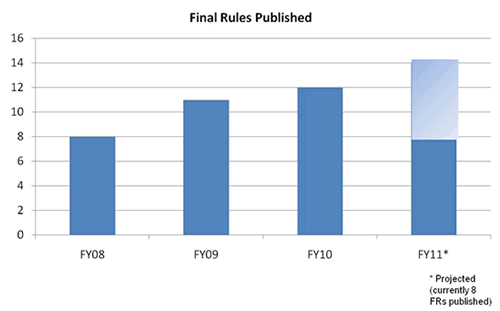Rayburn House Office Building
Introduction
Good morning Mr. Chairman and distinguished members of the subcommittee. It is our pleasure to be here today to discuss the Coast Guard’s regulatory program.
Beginning with the establishment of the Steamboat Inspection Service, the Coast Guard has been publishing regulations for more than 150 years, with a proven track record of managing maritime risk in a cost-effective manner. Building on these successes, the Coast Guard has been modernizing its approach to regulatory development by increasing its workforce and process transparency, streamlining processes, and scrutinizing all regulatory actions to ensure the maritime industry operates in a safe, secure, and environmentally sound manner while promoting maritime commerce. The Coast Guard’s Regulatory Development Program (RDP) has continued its success, earning dividends from program enhancements and a reinvigorated focus on the impacts of regulations allowing for increased emphasis on the requirements set forth in the Coast Guard Authorization Act of 2010 (CGAA2010).
Overview of Coast Guard Regulatory Program
The Coast Guard’s RDP manages the publication of regulatory actions covering the spectrum of maritime safety, security, and stewardship issues. Consistent with the nature of the Service’s broad maritime missions, the Coast Guard’s regulatory actions typically span more than one issue or benefit area. For instance, a rule associated with vessel position and movement reporting promotes safety and security through enhanced awareness within the maritime community, reducing the potential for vessel mishaps and increasing awareness of traffic and potential terrorist targets. In addition, this reduction in vessel mishaps also reduces the likelihood of damage to our natural resources from a vessel casualty. As such, Coast Guard regulatory actions and corresponding resource investments result in multiple benefits across the spectrum of the Coast Guard’s maritime mission.
At a high level, the regulatory development process can be viewed in four parts as shown in Figure 1: policy development; rulemaking documentation development; internal and external review; and publication.

Figure 1: Rulemaking Process
The first phase, policy development, accounts for the bulk of time spent on regulatory development and can take multiple years depending on the complexity of the issues involved. During this phase, the Coast Guard draws upon internal and external expertise, research, interaction with stakeholders and other tools to ensure that (1) there is a full understanding of the issue to be addressed, and (2) various options for addressing the subject of rulemaking are considered so that the right decision can be made.
Once a policy is developed and approved, the process for developing the rulemaking documentation should take seven to nine months, again, depending upon the complexity of the issue/solution. During this time, assessments of cost, benefit, small business, environmental and other impacts are refined, and rulemaking documentation prepared. Proposed rules are then subjected to review by subject matter experts and leadership, as depicted in Figure 2, including review by the cognizant Coast Guard Director and a departmental review at the Department of Homeland Security (DHS). While this process incurs a significant investment of time and resources, this review process ensures that the right policy decisions have been made during the Policy Development stage.

Figure 2: Non-Significant Rule Clearance Process
This review process is expanded for rules classified as “significant” per Executive Order 12866. As shown in Figure 3, the reviews within the Coast Guard are broadened for such rules to include an additional review by the Marine Safety and Security Council (MSSC), additional review within DHS, and review at the Office of Information and Regulatory Affairs (OIRA) in the Office of Management and Budget (OMB). These additional senior-level reviews further ensure the Coast Guard is meeting mission goals while avoiding excessive costs to the industry, unnecessary adverse impact on maritime commerce, or actions inconsistent with policies of other federal agencies.

Figure 3: Significant Rule Clearance Process
The Coast Guard’s RDP is comprised of two core offices: the Office of Regulations and Administrative Law (CG-094) and the Office of Standards Evaluation and Development (CG-523). Together, the two offices dedicate 16 attorneys, one paralegal, 23 economists, four environmental analysts, 15 technical writers, 21 project managers, and two overall managers, for a total of 82 full-time personnel to the RDP.
The staff dedicated to rulemaking development is complemented by members from across Coast Guard headquarters who serve as subject matter experts on rulemaking project teams. They are responsible for the wide range of commercial maritime sector safety, security, and environmental protection programs assigned to the Coast Guard. In addition to developing new regulations when needed, they also develop enforcement policy, industry guidance, and Coast Guard field office guidance.
In addition to dedicating significant resources to the RDP, the Coast Guard initiated major reforms to processes, training, and other capabilities, including the Rulemaking Review and Reform Project (2009). This initial reform effort has been followed by a continuous series of improvements, focusing on refining and streamlining processes, developing performance measurement systems, and adopting more current information technology and project management capabilities. Coast Guard regulatory development is guided by the Mission Management System, an International Standards Organization (ISO) 9000-compliant program used to document, standardize, and streamline our rulemaking processes. Further investments in advanced project management training, commercial project management software and increased performance measurement will allow for enhanced tracking of projects and resources, driving further efficiencies.
The Coast Guard is beginning to see the results of the increased staffing, funding, training, and process streamlining and improvement. Figure 4 shows the increase in Final Rules published since the resources were added and reforms were enacted. As shown, the Coast Guard published 12 Final Rules in FY 2010 and eight so far in FY 2011, with another six to eight projected by the remainder of the fiscal year.
Additionally, the Coast Guard publishes approximately 20-30 rulemaking proposals (Notice of Proposed Rulemaking- NPRM, Advance NPRM, and Supplemental NPRM) per year, with progress made on more than 50 of the currently active regulatory projects in the past year. Furthermore, the average age of rules under development is currently 5.3 years, a decrease from 6.2 years at the end of FY 2009. The Coast Guard anticipates further reductions by prioritizing completing older rulemaking projects and eliminating the existing regulatory backlog.

Figure 4: Final Rules Published
Overall, active projects were reduced by 35 percent over the course of FY 2010. This reduction, however, was offset by increases in the regulatory workload resultant from the passage of CGAA2010 and additional regulations proposed by Coast Guard programs, which together increased the current active project list by 38 percent thus far in FY 2011. Of the requirements identified in CGAA2010 that will require regulations, 26 percent have been determined to be self-executing, with another 33 percent calling for regulations that can be incorporated into existing projects, and the remainder requiring new rulemaking projects in order to be implemented. All of these projects are underway, cognizant of the deadlines specified by Congress in certain provisions. With the addition of the regulations required by CGAA2010, 46 percent of the Coast Guard’s current rulemaking workload is legislatively mandated, 52 percent is originated by Coast Guard programs, and the remainder are required to ensure compliance with international treaties and standards.
In addition to working on traditional rulemaking projects, the Coast Guard is also working with DHS to implement the requirements of Executive Order 13563 (“Improving Regulation and Regulatory Review” January 18, 2011). The Coast Guard is incorporating the enhanced requirements of the Executive Order into its economic analyses. In addition, the Coast Guard is assisting in the development of the DHS-wide Preliminary Plan for the retrospective review of existing DHS regulations. The Preliminary Plan will identify how DHS will review its existing significant regulations “to determine whether any such regulations should be modified, streamlined, expanded, or repealed so as to make the agency’s regulatory program more effective or less burdensome in achieving the regulatory objectives.” For the Coast Guard, this has included the identification of Coast Guard rules for retrospective review as well as the review of comments posed by the public on regulations believed to be outdated, outmoded, or unnecessarily burdensome.
Reinvigorating Focus on Impacts of Regulations
In an effort to balance maritime safety, security, and stewardship while promoting commerce, the Coast Guard continues to focus on the practical impacts of each regulation. This focus is guided by Executive Order 13563, and includes a blend of international and domestic regulations and industry consensus standards, while simultaneously expanding flexibility. Additionally, the Coast Guard encourages strong stakeholder engagement and public participation throughout the regulatory process. Each of these is discussed further below.
- Presidential Executive Order 13563: While always a focus for Coast Guard rulemaking, the agency is adding further attention to the cumulative impacts of regulations, increasing formality of retrospective analyses, and renewing emphasis on small business impact for all regulatory actions as directed by Administration guidance. One illustrative example of such efforts is the recent update of requirements for personal flotation devices, which provided manufacturers greater flexibility in meeting Coast Guard safety objectives by incorporating new industry standards and best practices.
- Blend of International, Industry Consensus Standards and Domestic Regulations: OMB Circular A-119 establishes policies on federal use and development of voluntary consensus standards and conformity assessment activities. The Coast Guard effectively uses the blending of standards and regulations as a means to achieve desired compliance at a reduced cost and burden to the maritime industry. In our current regulations, the Coast Guard has incorporated by reference 641 industry consensus standards into 1,321 sections with greater than 52 percent of the technical sections in 33 and 46 CFR incorporating at least one standard by reference. This focus on incorporating existing international and industry consensus standards ensures the continuing efforts and achievements of the private sector in establishing standards utilized by the federal government. The use of such standards in federal regulations ensures effectiveness and promotes interoperability.
- Expansion of Flexibility: The Coast Guard uses a variety of mechanisms to provide flexibility for businesses to stylize compliance and reduce costs. One primary method is in working with affected stakeholders to find the most cost-effective solutions to the challenges presented. Another is in providing a variety of options for meeting regulatory objectives, including use of performance (vice prescriptive) standards and incorporation of industry standards by reference. Furthermore, regulations are intentionally tailored to reduce the burden on small entities. Finally, the Coast Guard emphasizes, when possible, the use of voluntary compliance alternatives such as the Alternate Compliance Program, which is administered through surveys and inspections conducted by authorized classification society surveyors, and the Streamlined Inspection Program where vessel owner/operators take an active role in examining their own vessels, documenting their findings, and taking corrective actions.
- Stakeholder Engagement and Public Participation: The Coast Guard embraces stakeholder input and public participation in the development of all regulatory actions. In addition to working alongside stakeholders in many standards committees as described previously, the Coast Guard further embraces engagement through many formal and informal meetings, the use of federal advisory committees, and attendance at industry and public interest group meetings ranging from the national and international level down to the local waterfront. The Coast Guard further maximizes access to information on regulatory actions through public meetings and public comment periods. Such engagement is critical to our understanding of current issues and challenges, and to our subsequent ability to execute our responsibilities for ensuring safety, security, and stewardship.
Conclusion
Providing an interactive and quality regulatory framework for safety, security, and stewardship for the maritime industry is a primary goal of the Coast Guard’s Regulatory Development Program. The Coast Guard understands the importance and value of developing and implementing regulations that target a particular area of need while balancing economic, environmental and other concerns. This is a greater challenge in tough economic times, but the Coast Guard’s strong partnerships with the maritime industry ensures that regulatory actions are in the best possible interest of all affected parties.
The Coast Guard is committed to meeting the requirements set forth in the Coast Guard Authorization Act of 2010, reducing the current regulatory backlog of older regulatory projects, balancing our program enhancements, and continuing to focus on the impacts of regulations.
Thank you for your continued support and the opportunity to testify before you today. We will be happy to answer any questions you may have.
